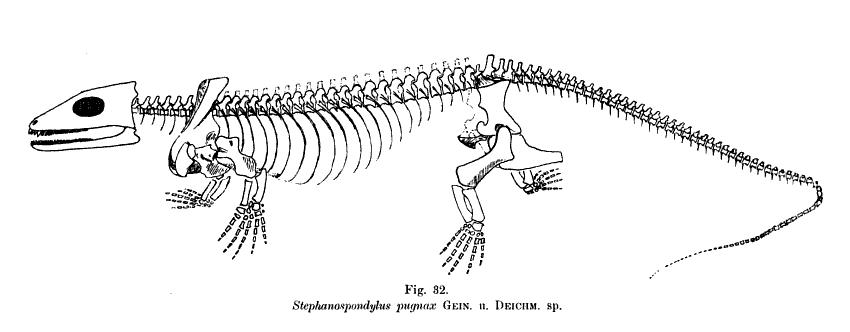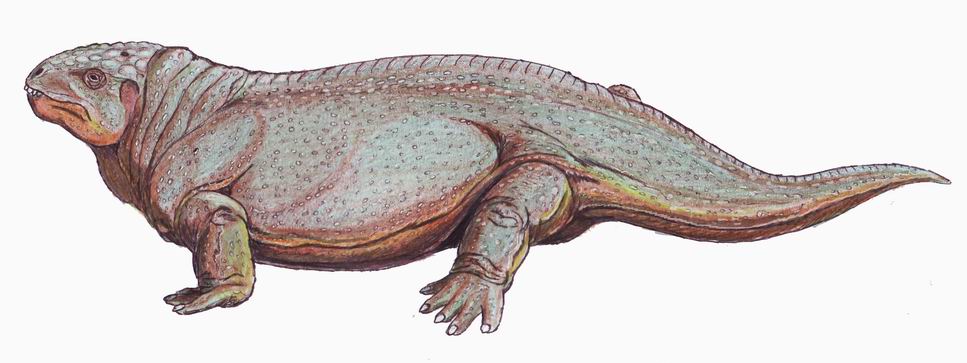|
Stephanospondylus
''Stephanospondylus'' is an extinct genus of diadectid reptiliomorph from the Early Permian of Germany. Fossils have been found in deposits of the Lower Rotliegend near Dresden. The type species ''S. pugnax'' was originally referred to the genus ''Phanerosaurus'' in 1882 but was placed in its own genus in 1905. Description ''Stephanospondylus'' is known only from several vertebrae and fragments of the upper and lower jaws. It was named in 1882 on the basis of two slabs, the fossils in which were thought to represent two individuals. With the erection of a new genus in 1905, the fossils were considered to be part of a single individual. In 1925, Alfred Romer determined that only parts of the jaws and some vertebrae belonged to ''Stephanospondylus''; the other material belonged to the temnospondyl amphibian '' Onchiodon''. ''Stephanospondylus'' has spade-shaped teeth adapted to cutting plant material. The vertebrae are distinct from those of other diadectids in that they lack ... [...More Info...] [...Related Items...] OR: [Wikipedia] [Google] [Baidu] |
Diadectid
Diadectidae is an extinct family (biology), family of early tetrapods that lived in what is now North America and Europe during the Late Carboniferous and Early Permian in Asia during the Late Permian. They were the first herbivore, herbivorous tetrapods, and also the first fully terrestrial animals to attain large sizes. Footprints indicate that diadectids walked with an erect posture. They were the first to exploit plant material in terrestrial food chains, making their appearance an important stage in both vertebrate evolution and the development of terrestrial ecosystems. The best known and largest representative of the family is ''Diadectes'', a heavily built animal that attained a maximum length of several metres. Several other genera and various fragmentary fossil remains are also known. Although well known genera like ''Diadectes'' first appear in the Late Pennsylvanian, fragmentary remains of possible diadectids are known from much earlier deposits, including a piece of l ... [...More Info...] [...Related Items...] OR: [Wikipedia] [Google] [Baidu] |
Diadectids
Diadectidae is an extinct family of early tetrapods that lived in what is now North America and Europe during the Late Carboniferous and Early Permian in Asia during the Late Permian. They were the first herbivorous tetrapods, and also the first fully terrestrial animals to attain large sizes. Footprints indicate that diadectids walked with an erect posture. They were the first to exploit plant material in terrestrial food chains, making their appearance an important stage in both vertebrate evolution and the development of terrestrial ecosystems. The best known and largest representative of the family is '' Diadectes'', a heavily built animal that attained a maximum length of several metres. Several other genera and various fragmentary fossil remains are also known. Although well known genera like ''Diadectes'' first appear in the Late Pennsylvanian, fragmentary remains of possible diadectids are known from much earlier deposits, including a piece of lower jaw found in ... [...More Info...] [...Related Items...] OR: [Wikipedia] [Google] [Baidu] |
Phanerosaurus
''Phanerosaurus'' is an extinct genus of diadectid reptiliomorph from the Early Permian of Germany. Fossils are known from the Leukersdorf Formation near Zwickau. German paleontologist Christian Erich Hermann von Meyer named the type species ''P. naumanni'' in 1860 on the basis of several sacral and presacral vertebrae. A second species, ''P. pungnax'', was named in 1882 but placed in its own genus '' Stephanospondylus'' in 1905. Description Like those of other diadectids, the vertebrae of ''Phanerosaurus'' are very wide. The neural arch The spinal column, a defining synapomorphy shared by nearly all vertebrates, Hagfish are believed to have secondarily lost their spinal column is a moderately flexible series of vertebrae (singular vertebra), each constituting a characteristic ...es are very tall and extend beyond the centra with prominent zygapophyses projecting from either side. There are few distinctive features in the vertebrae of ''Phanerosaurus'' to distinguish ... [...More Info...] [...Related Items...] OR: [Wikipedia] [Google] [Baidu] |
Temnospondyl
Temnospondyli (from Greek τέμνειν, ''temnein'' 'to cut' and σπόνδυλος, ''spondylos'' 'vertebra') is a diverse order of small to giant tetrapods—often considered primitive amphibians—that flourished worldwide during the Carboniferous, Permian, and Triassic periods. A few species continued into the Jurassic and Cretaceous periods. Fossils have been found on every continent. During about 210 million years of evolutionary history, they adapted to a wide range of habitats, including freshwater, terrestrial, and even coastal marine environments. Their life history is well understood, with fossils known from the larval stage, metamorphosis, and maturity. Most temnospondyls were semiaquatic, although some were almost fully terrestrial, returning to the water only to breed. These temnospondyls were some of the first vertebrates fully adapted to life on land. Although temnospondyls are considered amphibians, many had characteristics, such as scales and armour-like bo ... [...More Info...] [...Related Items...] OR: [Wikipedia] [Google] [Baidu] |
Permian Germany
The Permian ( ) is a geologic period and stratigraphic system which spans 47 million years from the end of the Carboniferous Period million years ago (Mya), to the beginning of the Triassic Period 251.9 Mya. It is the last period of the Paleozoic Era; the following Triassic Period belongs to the Mesozoic Era. The concept of the Permian was introduced in 1841 by geologist Sir Roderick Murchison, who named it after the region of Perm in Russia. The Permian witnessed the diversification of the two groups of amniotes, the synapsids and the sauropsids ( reptiles). The world at the time was dominated by the supercontinent Pangaea, which had formed due to the collision of Euramerica and Gondwana during the Carboniferous. Pangaea was surrounded by the superocean Panthalassa. The Carboniferous rainforest collapse left behind vast regions of desert within the continental interior. Amniotes, which could better cope with these drier conditions, rose to dominance in place of their amphi ... [...More Info...] [...Related Items...] OR: [Wikipedia] [Google] [Baidu] |
Cisuralian Tetrapods Of Europe
The Cisuralian is the first series/epoch of the Permian. The Cisuralian was preceded by the Pennsylvanian and followed by the Guadalupian. The Cisuralian Epoch is named after the western slopes of the Ural Mountains in Russia and Kazakhstan and dates between 298.9 ± 0.15 – 272.3 ± 0.5 Mya. The Cisuralian is often synonymous with the informal terms early Permian or lower Permian. It corresponds approximately with the Wolfcampian in southwestern North America. The series saw the appearance of beetles and flies and was a relatively stable warming period of about 21 million years. Name and background The Cisuralian is the first series or epoch of the Permian. The Cisuralian was preceded by the last Pennsylvanian epoch (Gzhelian) and is followed by the Permian Guadalupian Epoch. The name "Cisuralian" was proposed in 1982, and approved by the International Subcommission on Permian Stratigraphy in 1996. The Cisuralian Epoch is named after the western slopes of the Ural Mountains ... [...More Info...] [...Related Items...] OR: [Wikipedia] [Google] [Baidu] |
Holotype
A holotype is a single physical example (or illustration) of an organism, known to have been used when the species (or lower-ranked taxon) was formally described. It is either the single such physical example (or illustration) or one of several examples, but explicitly designated as the holotype. Under the International Code of Zoological Nomenclature (ICZN), a holotype is one of several kinds of name-bearing types. In the International Code of Nomenclature for algae, fungi, and plants (ICN) and ICZN, the definitions of types are similar in intent but not identical in terminology or underlying concept. For example, the holotype for the butterfly '' Plebejus idas longinus'' is a preserved specimen of that subspecies, held by the Museum of Comparative Zoology at Harvard University. In botany, an isotype is a duplicate of the holotype, where holotype and isotypes are often pieces from the same individual plant or samples from the same gathering. A holotype is not necessaril ... [...More Info...] [...Related Items...] OR: [Wikipedia] [Google] [Baidu] |
Onchiodon
''Onchiodon'' is an extinct genus of temnospondyl. It is primarily known from the Carboniferous and Permian The Permian ( ) is a geologic period and stratigraphic system which spans 47 million years from the end of the Carboniferous Period million years ago (Mya), to the beginning of the Triassic Period 251.9 Mya. It is the last period of the Pale ... of Europe, but also from the Permian of North America. It was an amphibious carnivore. A number of species have been described: References Eryopids Prehistoric amphibian genera Carboniferous temnospondyls of Europe Permian temnospondyls of Europe Permian temnospondyls of North America Fossil taxa described in 1861 {{Temnospondyli-stub ... [...More Info...] [...Related Items...] OR: [Wikipedia] [Google] [Baidu] |
Amphibian
Amphibians are four-limbed and ectothermic vertebrates of the class Amphibia. All living amphibians belong to the group Lissamphibia. They inhabit a wide variety of habitats, with most species living within terrestrial, fossorial, arboreal or freshwater aquatic ecosystems. Thus amphibians typically start out as larvae living in water, but some species have developed behavioural adaptations to bypass this. The young generally undergo metamorphosis from larva with gills to an adult air-breathing form with lungs. Amphibians use their skin as a secondary respiratory surface and some small terrestrial salamanders and frogs lack lungs and rely entirely on their skin. They are superficially similar to reptiles like lizards but, along with mammals and birds, reptiles are amniotes and do not require water bodies in which to breed. With their complex reproductive needs and permeable skins, amphibians are often ecological indicators; in recent decades there has been a dramat ... [...More Info...] [...Related Items...] OR: [Wikipedia] [Google] [Baidu] |
Early Permian
01 or '01 may refer to: * The year 2001, or any year ending with 01 * The month of January * 1 (number) Music * 01'' (Richard Müller album), 2001 * ''01'' (Son of Dave album), 2000 * ''01'' (Urban Zakapa album), 2011 * ''O1'' (Hiroyuki Sawano album), 2015 * 01011001, the seventh studio album from Arjen Anthony Lucassen's Ayreon project Other uses * 01 (telephone number), United Kingdom internal dialing code for London between the late 1950s and 1990 * Lynk & Co 01, a compact SUV built since 2017 * Zero One also known as ''Machine City'', a city-state from the ''Matrix'' series * Kolmogorov's zero-one law, a law of probability theory * Pro Wrestling ZERO1-MAX, a wrestling promotion formerly known as Pro Wrestling ZERO-ONE * BAR 01, a Formula One chassis * The number of the French department Ain * The codename given to the Wing Gundam by Oz in the anime ''Gundam Wing'' See also * One (other) One or 1 is the first natural number. 1, one, or ONE may also refer ... [...More Info...] [...Related Items...] OR: [Wikipedia] [Google] [Baidu] |





.png)